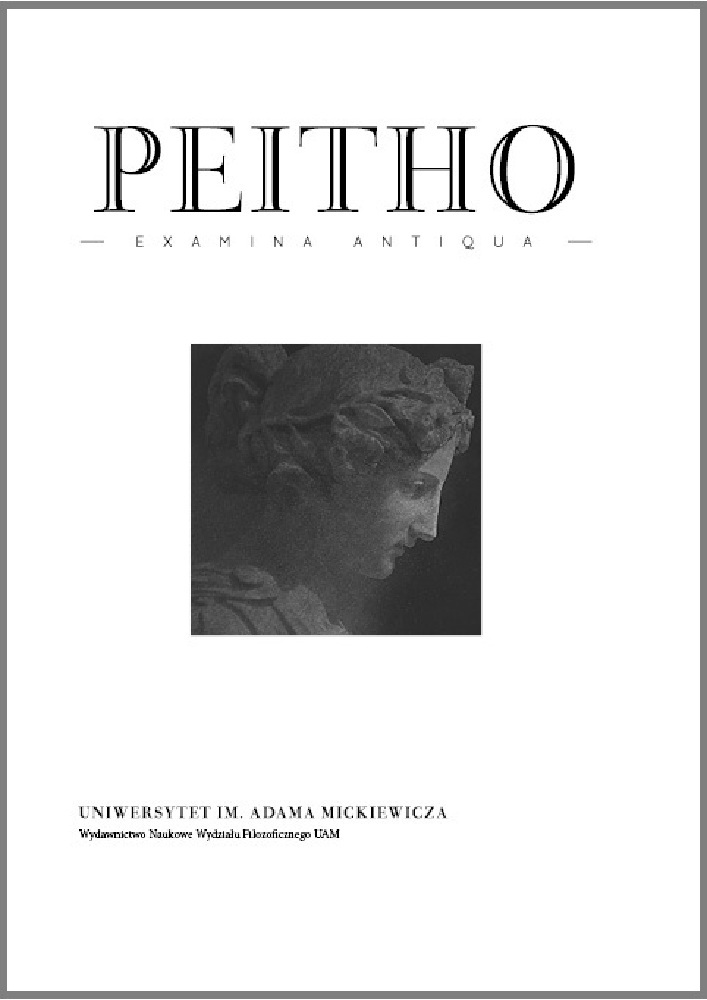Abstract
This paper presents Olympiodorus’ and Damascius’ explanations of the philosopher’s practice of dying in Plato’s Phaedo. It also includes a presentation of Ammonius’ exegesis of the practice of death (meletē thanatou). The Neoplatonic commentators discern two kinds of death, the bodily or physical death and the voluntary death. Olympiodorus suggests that bodily death is only an image of voluntary death and cannot be recognized as an original death, because original death presupposes the preparation for death and the constant effort for the purification of the soul during the philosopher’s life-time. Only preparation for death and purification can ensure the complete separation of the soul from the body. Relative to this distinction is that between apothnēskein and tethnanai; these infinitives denote the dual meaning of death: death as an event or a process and death as a state. Our study examines thoroughly the subtle distinctions made by Olympiodorus and Damascius and offers a comparative analysis of the two definitions of death as well as that of purification. It reaches the conclusion that apothnēskein is a necessary condition of tethnanai, i.e. of a definitive release and parting of the soul from the body. On the other hand, the process of eventual purification, a notion which betrays the religious character of purification, can be identified with apothnēskein, which is the practice of dying by the true philosopher. Finally, our study also emphasizes and explains the difference between the voluntary philosophical death and the voluntary unphilosophical suicide; the latter guaranteeing only bodily or physical death.
References
Archer-Hind, R.D., 1894, The Phaedo of Plato, London.
Baltzly, D., 2009, Proclus. Commentary on Plato’s Timaeus, Volume IV, Book 3, Part II: Proclus on the World Soul, translated with an introduction and notes, Cambridge.
Bormann, K., 2003 (1973), Platon, Freiburg und München.
Bostock, D., 1986 (repr. 2000), Plato’s Phaedo, Oxford.
Brickhouse, T.C. and Smith, N.D., 2010, Socratic Moral Psychology, Cambridge.
Burnet, J., 1911, Plato’s Phaedo, edited with introduction and notes, Oxford.
Busse, A. 1891, (ed.), Ammonius, In Porphyrii Isagogen sive V voces, CAG IV3, Berolini.
Chen, L.C.H., 1992, Acquiring knowledge of the Ideas, A Study of Plato’s Methods in the Phaedo, the Symposium and the Central Books of the Republic, Stuttgart.
Ebert, T., 2004, Phaidon, Übersetzung und Kommentar, Göttingen.
Frede, D., 2010 (1999), Platons ›Phaidon‹. Der Traum von der Unsterblichkeit der Seele, Darmstadt.
Gallop, D., 1975, Plato, Phaedo, Translation with Notes, Oxford.
Gertz, S.R.P., 2011, Death and Immortality in Late Neoplatonism, Studies on the Ancient Commentaries on Plato’s Phaedo, Leiden and Boston.
Hackforth, R., 1955, Plato’s Phaedo, translated with introduction and commentary, Cambridge.
Jowett, B., Plato: Phaedo, translated with an introduction, Oxford (web edition).
Loriaux, R., 1981 (1re édition 1969/1975), Le Phédon de Platon, Commentaire et traduction, Vol. I–II, Gembloux.
Plato I, Euthyphro – Apology – Crito – Phaedo – Phaedrus, transl. H.N. Fowler, Cambridge and London.
Rowe, C.J., 1993, Plato. Phaedo, Cambridge.
Sedley, D., Long, A. 2011, (eds.), Plato: Meno and Phaedo, Cambridge.
Warren, J., 2001, “Socratic Suicide”, The Journal of Hellenic Studies 121, pp. 91–106.
Westerink, L.G., 1956, Olympiodorus: Commentary on the First Alcibiades of Plato, Amsterdam.
Westerink, L.G., 2009 (1976), The Greek Commentaries on Plato’s Phaedo, I Olympiodorus, II Damascius, Westbury.
White, F.C., 2006, “Socrates, Philosophers and Death: Two Contrasting Arguments in Plato’s Phaedo”, The Classical Quarterly 56, pp. 445–458.
License
Peitho provides immediate open access to its content on the principle that making research freely available to the public supports a greater global exchange of knowledge.
